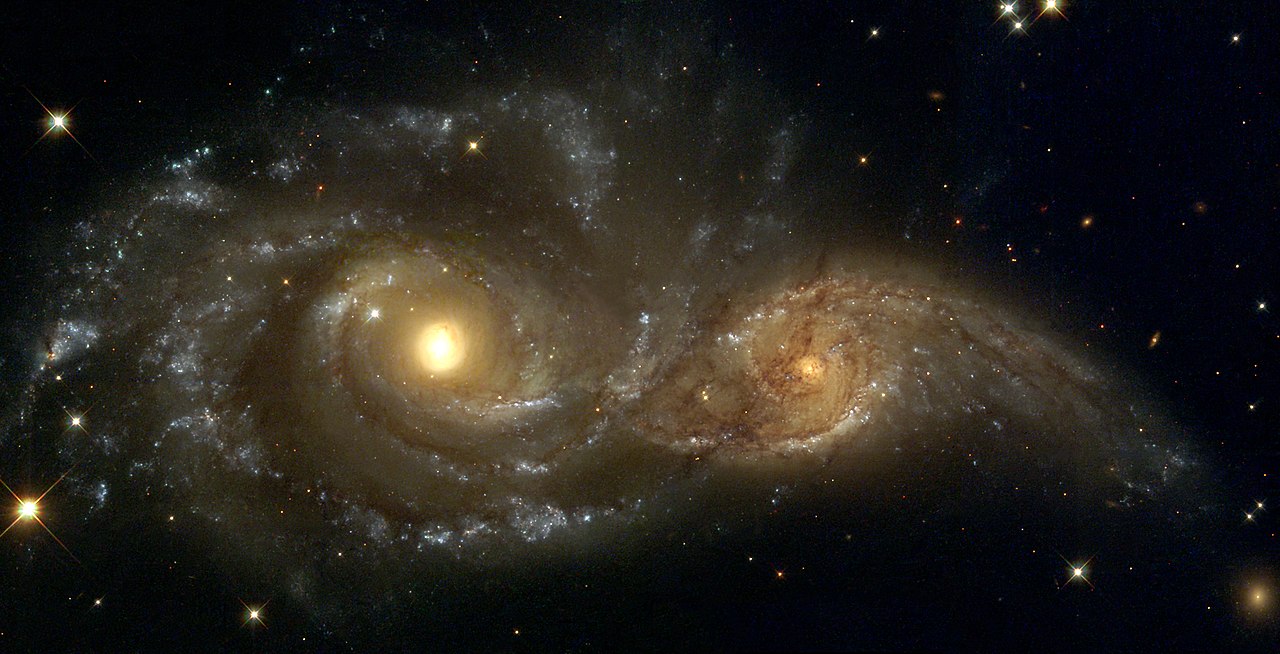Elusive intergalactic light from orphaned stars studied for 1st time
"We know almost nothing about intra-group light."

Astronomers have for the first time studied the elusive faint glow emanated by stars that have been ripped from their homes and now exist as cosmic orphans between galaxies.
The team used a new technique to study this so-called "intra-group light" and tell the story of how displaced stars were woven through a group of galaxies. Because these galaxies are seen as they were 2.5 billion years ago, the research could make a valuable contribution to our understanding of cosmic evolution.
"We know almost nothing about intra-group light," University of South Wales school of physics scientist, Cristina Martínez-Lombilla, said in a statement. "Unveiling the quantity and origin of the intra-group light provides a fossil record of all the interactions a group of galaxies has undergone and provides a holistic view of the system's interaction history," Martínez-Lombilla said.
Related: James Webb Space Telescope peers into the 'ghostly light' of interstellar space
The astronomers used a technique that eliminates light from all other sources barring intra-group light. In addition to detecting this faint light, the process allowed the team to tell the story of the stars that dwell in the space between galaxies.
"We analyzed the properties of the intra-group stars — those stray stars between the galaxy groups," Martínez-Lombilla. "We looked at the age and abundance of the elements that composed them and then we compared those features with the stars still belonging to galaxy groups."
The team discovered that intra-group light indicates these stars are younger and less rich in elements heavier than hydrogen and helium — referred to as metals by astronomers — than stars in the galaxies that surround them.
Get the Space.com Newsletter
Breaking space news, the latest updates on rocket launches, skywatching events and more!
This implies that not only are these orphan stars anachronistic — appearing to belong to a different time — but that they seem to be of a different origin to their neighboring stars. In fact, the astronomers think that the intra-group stars have more in common with stars that occupy the nebulous 'tail' of a more distant galaxy. "These events occurred a long time ago. The galaxies [we're looking at] are so far away, that we're observing them as they were 2.5 billion years ago. That is how long it takes for their light to reach us," Martínez-Lombilla said in the statement.
Using this information, the team retraced the history of the intra-group stars and how they came to be gathered in a stellar orphanage between galaxies. "We think these individual stars were at some points stripped from their home galaxies and now they float freely, following the gravity of the group," Martínez-Lombilla explained.
This ripping of stars from galaxies is called tidal stripping, and it is caused by the passage of massive satellite galaxies — similar to the Milky Way — and their gravitational influence dragging stars in their wake.

In order to get this first-time view of intra-group light, the astronomers developed a special image treatment process that allowed them to analyze the faintest light. "The brightest parts of the intra-group light are around 50 times fainter than the darkest night sky on Earth. It is extremely hard to detect, even with the largest telescopes on Earth — or in space," Martínez-Lombilla said.
To do this, the team had to come up with their own method for viewing this faint light. "We have developed a tailored image treatment procedure that allows us to analyze the faintest structures in the universe. It follows the standard steps for the study of faint structures in astronomical images — which implies 2D modeling and the removal of all light except that coming from the intra-group light," Martínez-Lombilla added.
Martínez-Lombilla explained that this involves blocking out light from all the bright stars in the images, and light from the galaxies which usually obscures the intra-group light. "The most important outcome is that when studying very faint structures around galaxies, every step in the process counts, and [all] undesirable light should be accounted for and removed," Martínez-Lombilla said. "Otherwise, your measurements will be wrong."
The team now aims to use this process beyond this group of galaxies to a large sample of similar groupings. "Then we can look at statistics and find out the typical properties regarding the formation and evolution of the intra-group light and these extremely common systems of groups of galaxies," Martínez-Lombilla added.
Because the team's treatment method is fully based on the versatile and open-source Python coding language, Martínez-Lombilla explained it is very modular. This means it can be easily applied to different data sets from a range of telescopes.
"This is key work for preparing the next generation of deep all-sky surveys such as those to be performed with the Euclid space telescope and the LSST with the Vera C. Rubin Observatory," Martínez-Lombilla concluded.
The team's research is published in the journal Monthly Notices of the Royal Astronomical Society.
Follow us on Twitter @Spacedotcom or on Facebook.
Join our Space Forums to keep talking space on the latest missions, night sky and more! And if you have a news tip, correction or comment, let us know at: community@space.com.

Robert Lea is a science journalist in the U.K. whose articles have been published in Physics World, New Scientist, Astronomy Magazine, All About Space, Newsweek and ZME Science. He also writes about science communication for Elsevier and the European Journal of Physics. Rob holds a bachelor of science degree in physics and astronomy from the U.K.’s Open University. Follow him on Twitter @sciencef1rst.









